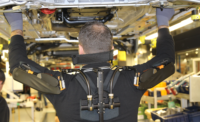With a focus on productivity and encouragement of social distancing on construction sites, tool manufacturer Hilti has announced a raft of new products, including the EXO-O1, a wearable mechanical exoskeleton. Citing an aging workforce and the need to recruit a new generation, Hilti says the exoskeleton will reduce some of the strains associated with repetitive labor.
“This exoskeleton is one step into a family of products to improve life” for workers, says Rafael Garcia, Hilti senior vice president and chief marketing officer. “We want to offer solutions to make the work easier, while being able to execute the applications customers need.”
The non-powered, mechanical exoskeleton was developed with German-based prosthetics manufacturer Ottobock and is designed to reduce strain on upper-body muscles and joints when working overhead. A system of pulleys and cables transfers weight from the arms to the hips, making it easier to hold tools or materials overhead for extended periods of time.
“We see this as a way to help people work safer on jobsites,” says Ed Selz, Hilti business unit manager for diamond products and consumables. “It’s designed for all-day usage and does not impede your range of motion when reaching overhead or bending over.” The exoskeleton is meant to be worn at the waistline above a toolbelt and has been designed not to interfere with fall-protection harnesses. The EXO-O1 will available for purchase later this year, Garcia says.
Hilti also announced the PMD 200, an affordable green-laser layout system for indoor use. Paired with a rugged tablet, which is included, the PMD 200 is intended for tradeworkers who need precision layouts but don’t want to invest in a robotic total station or a full 3D layout system. “Digital workflows are being adopted more, but we only see total stations on 10% of projects,” says Aiden Maguire, Hilti business unit manager for measurement. “This [laser] fits between the total station and traditional methods.”
Layout values can be entered into the tablet, and it can perform basic geometric calculations. The laser then automatically moves between preset points, waiting for the user to set the reflector and mark the points off. The tool requires only one user for layout, which Hilti says may help meet current social-distancing requirements on indoor jobsites where traditional layout tasks often require two workers.





